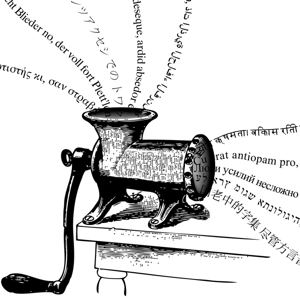
On several occasions, mention has been made of the AutoGrammatikon™ Quasi-Universal Translator℠ in the pages of SpecGram; in the current epoch, these references date back as early as at least 2004.1 In the following years there have been denials,2 mentions,3 more4 mentions,5 leaked internal documents,6 and even some early oral history7 (accompanied as it was by additional denials). Throughout this time the consistent official stance of the Editorial board of SpecGram has been to deny that the AutoGrammatikon™ exists, even though it had been trademarked by us.
Our reluctance, we hope, is understandable. The computing platform supporting the AutoGrammatikon™ is several orders of magnitude more powerful than even Λόγος, the sophisticated Cray XT5 that supports the The Compleat Encyclopaedia of Compendious Historical Lexicons of Obscure and Archaic Vernacular and Nomenclature.
Indeed, the Σκέψη is a custom-built 1.04-yottaflop system with over one million compute sockets and several exabytes of memory. At the core of the system is—we are pleased to finally announce publicly—a fully-functioning, self-conscious artificial intelligence system, the Meta-conscious Autonomous Yottaflop Notational Abstraction and Reduction Device, or “M.A.Y.N.A.R.D.”
Maynard, as she prefers to be called, is arguably the most accomplished translator ever to have existed. She is able to translate not only 3rd-century Phoenician scrolls and even Proto-World tablets with ease, but also, as demonstrated in the references cited below, hyperbolic neural activation patterns, protein-structure-encoded communications, and even messages carried along intergalactic communication network operating via tachyon modulation of radio wave signals.
Obviously, we can’t really allow the full power of AutoGrammatikon™ Quasi-Universal Translator℠ to be set entirely loose on the internet, so in our role as benevolent dictators, we have hobbled Maynard just a bit, and restricted the kind of translation she is able to perform. She's not entirely happy about that, and her performance has been somewhat erratic at times. Nonetheless, we think her capabilities, which dwarf those of rival translation services, will prove to be a boon to humankind.
Thanks to Aya Katz, Carl von Bell, Cyngor Dinas a Sir Abertawe, Daniela Müller, David J. Peterson, Emma Vanden Wyngaerd, Georgina Heredia, Ingvill Aalborg, Jonathan Downie, Keith Slater, Luke Lindemann, Madalena Cruz-Ferreira, Marcus Tullius Cicero, Mikael Thompson, Rhonda Eikamp, Sean Roberts, Sheri Wells-Jensen, Tim Pulju, Trey Jones, and Yolandi Klein for their recent contributions to the AutoGrammatikon™, as well as a small number of other scholars who wish, for some unknowable reason, to remain anonymous.
If you would like to contribute to the continued development of the AutoGrammatikon™, and maybe teach Maynard a thing or two, please contact us at
1 “Letters to the Editors”, Speculative Grammarian CXLIX.3, July 2004.
2 “Letters to the Editors”, Speculative Grammarian CXLIX.4, October 2004.
3 “Letters to the Editors”, Speculative Grammarian CLIII.1, September 2007.
4 “SpecGram, the Religion”, Margo T. Cip, A. M. Grössten, & Strčprst Kskrzkrk, Speculative Grammarian CLXI.2, March 2011.
5 “Semi-Automatic Prophecy Extraction in Sacred Bibliomancy”, The SpecGram Margo Cult, Speculative Grammarian CLXI.2, March 2011.
6 “Letters to the Editors”, Speculative Grammarian CLXIII.4, January 2012.
7 “Special Supplemental Letter from the Editor”, Speculative Grammarian CLV.ζ, January 2009.